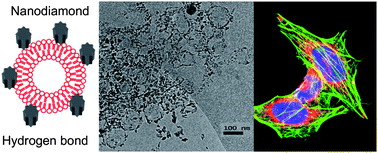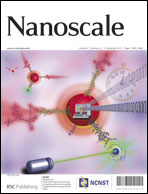Nanodiamond decorated liposomes as highly biocompatible delivery vehicles and a comparison with carbon nanotubes and graphene oxide†
Abstract
Studying interactions between nano-carbons and lipid membranes is important for multiplexed drug delivery, device fabrication and for understanding toxicity. Herein, we report that nanodiamond (ND, sp3 carbon) forms a complex with highly biocompatible zwitterionic liposomes based on hydrogen bonding, which is confirmed by pH-dependent and urea-dependent assays. Despite such weak interaction, the complex is highly stable. Comparisons were made with two sp2 carbons: nanoscale graphene oxide (NGO) and carbon nanotubes (CNTs), where CNT adsorption is the weakest. Adsorption of the nano-carbons does not induce liposome leakage or affect lipid phase transition temperature. Therefore, the potential toxicity of nano-carbons is unlikely to be related to direct membrane damage. ND facilitates cellular uptake of liposomes and co-delivery of negatively charged calcein and positively charged doxorubicin has been demonstrated. ND has the lowest toxicity, while CNTs and NGO are slightly more toxic. The effect of introducing fusogenic lipids and cholesterol was further studied to understand the effect of lipid formulation.


 Please wait while we load your content...
Please wait while we load your content...